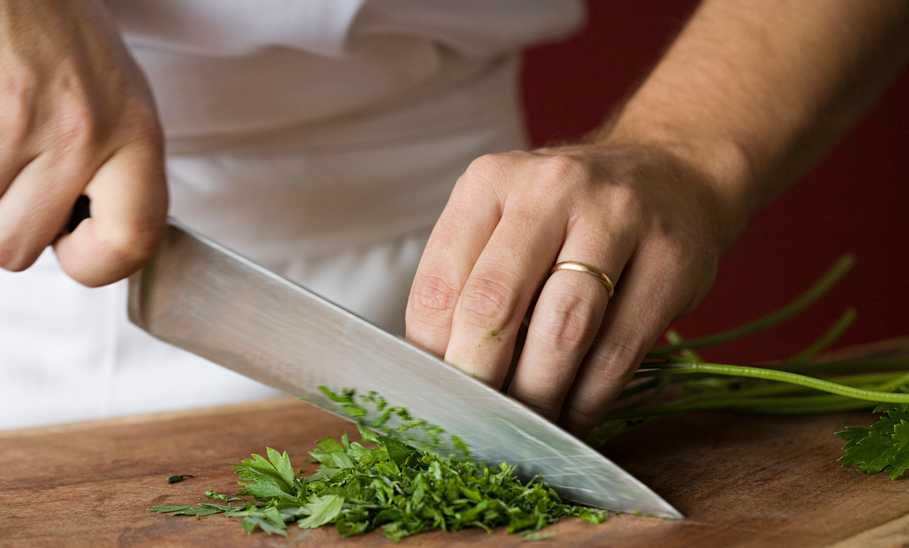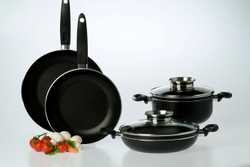- Weight: 8 ounces
- Material: high carbon steel
- Blade length: 8 inches
- Price on publish: $75
The Best Chef’s Knives For 2024

Our evaluations and opinions are not influenced by our advertising relationships, but we may earn a commission from our partners’ links. This content is created by TIME Stamped, under TIME’s direction and produced in accordance with TIME’s editorial guidelines and overseen by TIME’s editorial staff. Learn more about it.
If you’re only going to purchase a few knives for your home kitchen, make sure one of them is chef’s knife. This large, versatile knife is typically between 8 and 10 inches long, has a sharp, pointed tip and slightly curved blade and can be used to slice and chop everything from herbs and vegetables to meat and fish. Since you’ll likely be using it quite a bit, you want a chef’s knife that’s sharp, durable, and easy to use. We spoke with experienced and successful chefs and cookbook authors about what they look for in a chef’s knife so we could offer our picks on the best chef’s knives on the market. Read on to find the best one for you.

“Dalstrong is one of my favorites right now,” says chef Shereen Pavlides, author of Cooking with Shereen—Rockstar Dinners! “I like the weight, hand-feel and they are gorgeous with a fair price point.” As if that weren’t enough, this impressive chef’s knife comes in 13 handle colors to match your kitchen.

This subtle yet stylish knife from Material combines the best attributes of Japanese knives—the materials, the shape—with some Western touches—the composite handle, the wider base—to make a chef’s knife that’s able to handle any challenge.

Japanese knives are designed for the push-pull cutting style, in which you rock the knife back and forth across your food and use the whole blade, as opposed to the more Western style of chopping while keeping the tip of the knife on the cutting board. If you’re well-versed in this cutting style, this Tojiro knife is one of the best you can buy.


This is another knife that combines Japanese craftsmanship and materials with the style and approachability of Western knives. The result is a truly classic chef’s knife that’s attractive and will be at home in any kitchen.

“Dexter-Russell makes a great line of knives for entry-level or budget-friendly cooks that will never do you wrong,” says George Madosky, chef at Fork in Philadelphia, PA. “Though they won't feel as nice in the hand or look as nice, if that's something that matters to you.” Despite the plastic handle and slightly higher weight, this knife will do the job for a fraction of the price of most others.

Chef Kevin Cottrell, the executive chef and co-founder of Machete in Greensboro, NC, favors these unique blue steel no. 2 Japanese knives for “sharpness and precision.” The resulting blade is made from carbon steel, chromium, and tungsten, a combination that is known for its toughness and longer-term edge retention (i.e., you won’t have to sharpen it as often).

“I always consider the type of steel depending on the knife I’m looking for,” says Cottrell. “VG-10 is something more durable that can be beat up.” VG-10 is a special Japanese steel made from a combination of stainless steel and carbon steel to maximize both sharpness and durability. It’s a little pricey, but it will last.
To make our selections, we consulted with chefs and cookbook authors on the companies and knives they love and trust the most. From there, we combed the market to ensure that we were offering a variety of products suited to any and all home cooks.
According to the chefs we spoke to, there are a few factors to consider when buying chef knives.
Cottrell thinks about how he’s going to use the knife and what material best fits that task. If you’ll be slicing a lot of tougher foods, such as butternut squash or fatty meats, you’ll want a more durable material like VG-10 or stainless steel. But if you’re primarily chopping herbs, vegetables, or fish, you can go for a sharper and more delicate blade.
The way the knife feels in your hand is going to affect how often you want to use it. “I like the knife to be well-balanced right around my pointer finger when gripping the knife,” says Madosky. “So there should be a good amount of weight in the handle and the blade should feel light and agile.”
If the size of your knife’s handle is too big or too small for your hand, it’s going to get uncomfortable if you’re chopping for a while. “I have large hands and look for a knife with a slightly larger handle to make it more comfortable,” Madosky says. “The inverse is often true if you have small hands, you may want a smaller-handled knife.”
Just like when you’re considering the best dinnerware set or best coffee maker for you, think about if the look of your knives matters. “I look for aesthetics that appeal to me, because it might as well look super cool if I’m spending a pretty penny,” says Cottrell. If a snazzier knife is going to make you happier and more willing to prepare meals at home, it’s worth it.
The chefs we spoke to agree the best way to sharpen a chef’s knife to maximize its lifespan and integrity is with a whetstone. These slabs of stone generally have two sides, a coarser and a finer side, and are used to sharpen knives by drawing the blade back and forth across the stone. “There is a bit of a learning curve, but there are lots of great videos online to help you learn and once you get it, it's a great life skill,” Madosky says. “King Stone makes a great 1000/6000 stone that is great (basically all you need). I would also invest in a honing rod to keep your knife edge in line between sharpenings, but avoid the diamond-coated ones, as they will ruin your knife.”
From the variety of recommendations we received from the chefs we spoke to, we learned that knife selection has a lot to do with personal preferences. The other consideration professional chefs take into account is how they’re going to be using the knives, as some materials are more durable than others and certain knife makes and shapes are designed for certain ingredients and cutting styles.
Sure, if you need to. “I always recommend buying Sayas protective wooden covers, for your knives. With Sayas in place, there is little to worry about with your knives damaging each other in your bag,” Madosky says. “If you don't have a Saya, wrap each knife individually in a side towel and then wrap all your knives together in plastic wrap nice and tight.” And this probably goes without saying, but don’t try to bring them in your carry-on. “Since I travel abroad frequently for business, I often carry knives with me, and I always check them in during my travels,” shares chef Andy Matsuda, owner of the Sushi Chef Institute. “When going on international trips, I prefer to bring only the knives I regularly use and find easy to handle, rather than expensive ones. This precaution is taken with the possibility of losing them in mind.”
If you’re going to splurge on one knife in your kitchen arsenal, let it be your chef’s knife. This workhorse is so versatile, you can use it for virtually any task and if you’re a prolific cook then a higher-quality knife is well worth it. At the same time, just as with choosing any kitchen tool or appliance, such as the best air fryer, if you’ve used and are content with the performance of more budget-friendly knives, there’s no reason to upgrade just because. Choose the knife that will make your cooking experience the most enjoyable.
We wouldn’t recommend it. While the materials knives are made of are technically dishwasher safe, putting your chef knives in the dishwasher is going to dull the blades much faster than if you are gently hand washing them after each use.
The information presented here is created by TIME Stamped and overseen by TIME editorial staff. To learn more, see our About Us page.



